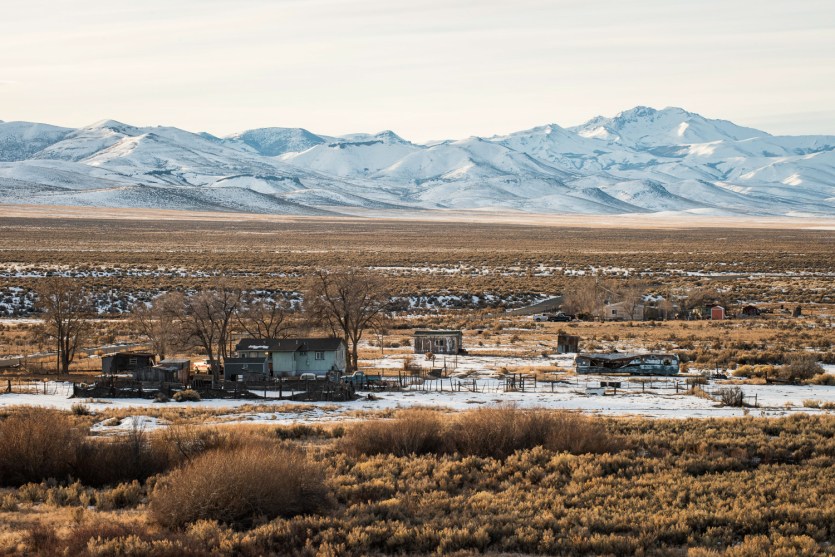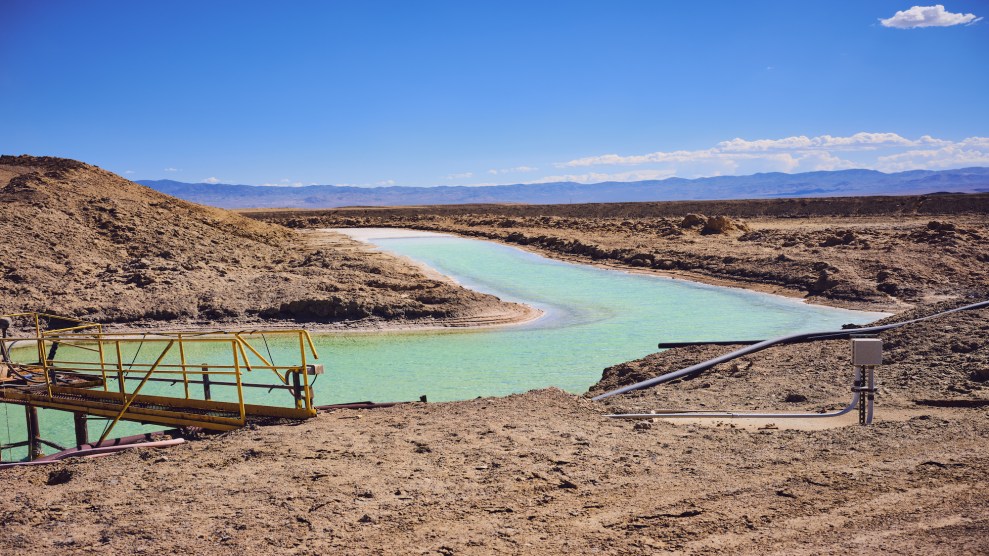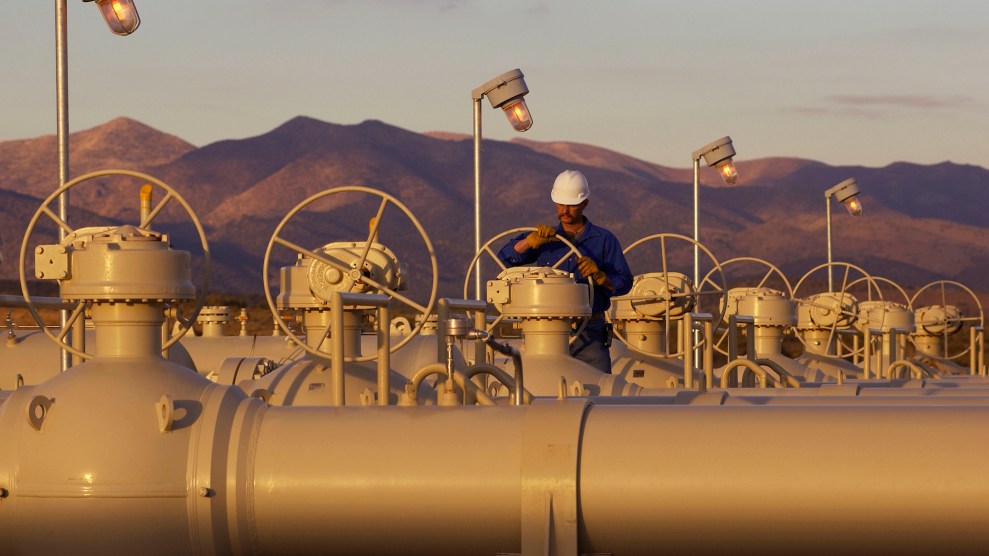
The Fort McDermitt Paiute and Shoshone reservation in Humboldt County, Nevada.Russel Albert Daniels / High Country News
This story was originally published by High Country News and is reproduced here as part of the Climate Desk collaboration.
In the Great Basin Desert of northern Nevada and southern Oregon, Thacker pass cuts a wide swath of sagebrush and bunch grasses between narrow ribbons of mountain ranges. The region is a caldera—a collapsed volcano—that formed an ancient lakebed. For millennia, Indigenous peoples used the verdant valley as a pathway between their winter and summer homes. Today, the Fort McDermitt Paiute Shoshone Tribe’s reservation is located nearby, along with the small agricultural community of Orovada, clusters of buildings surrounded by circular green fields of alfalfa.
The ancient lakebed clays are rich in lithium, and in January, the Bureau of Land Management approved the Thacker Pass lithium mine, an almost two-square-mile open-pit mine that will dig up the nation’s largest-known lithium supply. The mine will be run by Lithium Nevada, a subsidiary of Canadian-owned Lithium Americas. But its approval was rushed through during the coronavirus pandemic, and tribal members, ranchers and environmentalists have concerns about the mine’s potential long-term consequences.
Until now, lithium typically has been extracted from saline areas, such as Chile’s Atacama Desert, through an evaporative process. A relatively new technique using sulfuric acid to extract it from clay means the West is facing a new mining boom—and Nevada may soon be a global lithium-mining hotspot.
Lithium, the lightest metal, shines silvery when stored in protective oils. (Otherwise, it’s extremely flammable.) That lightness makes lithium ion batteries essential to everything from cellphones, to tablets, to Teslas. Lithium ion batteries also store energy for much longer than other batteries, so they can be important parts of solar and wind energy systems.
Electrovoltaic, or EV, vehicles are a growing part of efforts to combat climate change. For example, General Motors announced in January that it planned to stop making combustion-engine cars by 2035. But as anyone with an aging cellphone knows, lithium ion batteries degrade over time. What’s more, companies seldom recycle the batteries to reuse the rare metals inside them; it’s more cost-effective simply to mine for more.
In the Western United States, companies are rushing to develop lithium mines, partly because of new extraction methods, but also because the federal government is fast-tracking lithium mining. In 2018, the Interior Department listed lithium as a critical mineral, speeding up the mine permitting process. Last year, the Trump administration weakened and sped up the environmental review process for projects on federal lands, favoring mine approvals. Even as the Biden administration clamps down on extractive industries, such as by pausing oil and gas leases on public lands and offshore waters, lithium mining exploration continues apace, as part of the nation’s plan to wean itself from petroleum-powered cars.
This sped-up approval process makes public participation hard. As early as 2019, the BLM published a notice online that invited public comments on the Thacker Pass project, but included the wrong internet link for information about it. In 2020, the BLM held virtual public meetings about the mine’s potential environmental impacts less than a month before the public comment period closed. According to E & E News, the environmental review, often a multiyear process, took less than a year, with the final public comment period held over the winter holidays.
Although some commenters requested more time, citing the coronavirus pandemic, the Interior Department recommended expediting the mine’s approval to support economic recovery. Neither Lithium Nevada nor the Bureau of Land Management agreed to speak to High Country News about the project.
Lithium Nevada will work approximately 18,000 acres of BLM land about 26 miles from the Fort McDermitt Paiute Shoshone Reservation, in a sea of sagebrush on the Nevada-Oregon border hemmed to the north by the Montana Mountains. The region is the traditional homeland of several related Indigenous nations, including the Shoshone-Paiute Tribes of the Duck Valley Reservation, the Shoshone-Bannock Tribes of the Fort Hall Reservation, the Fort McDermitt Paiute Shoshone Tribe and the Burns Paiute Tribe.
Workers will build the mine 24 hours a day for the first two years. Starting in the second year, actual mining operations—such as digging the open-pit mine, pumping the ore to a processing facility, processing the lithium in industrial scrubbers, hauling waste rock to a stockpile, and trucking in materials to make sulfuric acid—will occur 24 hours a day for four decades. In a region where the average 2019 salary was about $21,000, Lithium Nevada says the mine’s average salary will be nearly quadruple that. The company predicts it will bring approximately 1,000 construction jobs to the region for two years of construction, and employ an operational staff of about 300 until the mine closes. The mine has been approved to run for about 40 years—longer, if the company finds more lithium.
Fort Mcdermitt Paiute Shoshone Tribal Councilperson Maxine Redstar hopes the mine will provide well-paid, highly skilled work to the reservation’s isolated community of approximately 340 people. But details about those jobs are scarce. Lithium Nevada is working closely with the tribe to do outreach and has worked with Great Basin Community College to develop construction training. In its environmental impact statement, however, it describes plans to bus operational workers in from Winnemucca, an hour away from the mine, where the population is less than 4% Native American.
Throughout 2020, the Fort McDermitt Paiute Shoshone Tribe contended with devastating coronavirus infection rates, and Redstar hopes that Lithium Nevada will commit to more community engagement, such as the youth summit and powwow Redstar organized with financial support from the company.
Previously, she worried that the much-needed economic stimulus would come at too high a cost, either to local communities or the environment, impacting native habitat, cultural foods, or the wild game that some tribal members still hunt traditionally. But at a February tribal council meeting, Lithium Nevada reassured Redstar that it will seriously consider any concerns raised by the tribe. “They are going to be doing reclamation every seven years,” Redstar said. “I’m feeling a little bit confident that they are doing everything they can to restore the way it was going to be.” Lithium Nevada also said they would help identify what kind of professional training tribal members needed in order to be employed at the Thacker Pass mine.
Still, others worry that the tribe doesn’t have enough information about the mine’s possible consequences, good or bad. Tribal Councilmember Billy A. Bell said he only learned about the mine’s approval by the BLM after High Country News asked for his comments. “It’s interesting how the tribe didn’t comment” on the project, Bell said. “And it’s too late now.”
This rushed approval process has frustrated local rancher Edward Bartell. Bartell’s family—fifth- or sixth-generation ranchers—has run cattle in Thacker Pass for a dozen years. His family’s cattle graze private property, where sturdy Great Basin wild rye sways across acres of land. Bartell believes that the project’s fast approval means that the BLM relied on the mining company for all the science, and he worries about the mine’s long-term effects on the region’s air and water quality.
Bartell didn’t start out opposed to the mine—in fact, the green energy angle sounded good to him. But as he looked into the potential impacts on his family business, he started to get worried. “My big thing is the BLM hasn’t done any other independent science,” Bartell said.
Bartell has not found direct communications with the company reassuring. For example, in an email sent in November 2019, Alexi Zawadzki, president of Lithium America’s North American operations, told him, “You’ll be pleased to know our operation will use very little water—approximately 2,500 acre-feet of well water per year.” However, when Bartell read the BLM’s final environmental impact statement, he learned that that estimate was for just the first four years of operation. After that, the mine will use twice as much water.
Bartell fears that the water table will drop dramatically. “It is a big devaluation of land value, if you have productive grassland, like you’re seeing out here, and suddenly it turns into barren dustbowl,” Bartell said. He has asked Lithium Nevada to compensate his business, but to no avail. In February, Bartell sued the BLM for rushing the environmental review.
He also worries about the approximately 5,800 tons of sulfuric acid the mine will eventually produce on-site each day. To make sulfuric acid, Lithium Nevada will ship the necessary chemicals in via rail to Winnemucca. From there, trucks will rumble down quiet roads, making up to 200 trips day and night between the town and mine facility—carrying hazardous materials to the mine’s on-site processing center, and mine products back to the railroad.
“What they’re going to have is more of an industrial facility here than just a mine. It’s going to have a chemical complex as well,” said John Hadder, director of the nonprofit Great Basin Resource Watch. “So there’s a lot of concerns about emissions, air quality, leaks, spills, all that kind of stuff.”
The fast-tracked approval process means that the BLM produced scant details about how the mine will affect rare species or unique habitat. The greater sage grouse, for example, stands to lose thousands of acres of habitat. A sage grouse lek, or courtship area, lies less than a mile from the future mine.
Even federal biologists have expressed concern about the rapid approval process. In a January letter to the Bureau of Land Management, Environmental Protection Agency project manager Jean Prijatel questioned the plan for long-term management after the mine closes down. According to Prijatel, without proper management, the mine will contaminate local groundwater with dangerous heavy metals, in particular a “plume” of antimony, for at least 300 years. Prijatel noted that though the BLM had “conceptual options” to address this plume, it offered no detailed mitigation plans, yet approved the mine anyway. She also questioned how the mine will monitor water pollution or share that information with the public. Prijatel did not respond to a request for comment from High Country News, although an EPA representative offered to answer questions provided in writing.
Hadder explained that the mine will eventually be dug deeper than the groundwater level. To keep it dry, the mining company will have to continuously pump water out. When the mine shuts down and the pumping stops, groundwater will seep back in, picking up newly exposed toxins, such as antimony. Lithium Nevada plans to treat groundwater for antimony pollution caused by the mine for several years after it closes. But Hadder worries that the antimony pollution may last far longer. “It has the potential of being an intergenerational pollution source, requiring perpetual management,” he said. “This is something that’s not getting a lot of play. And I think it’s part of the problem with the whole process, in not really giving people a full sense of what could happen.”















